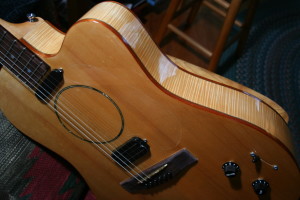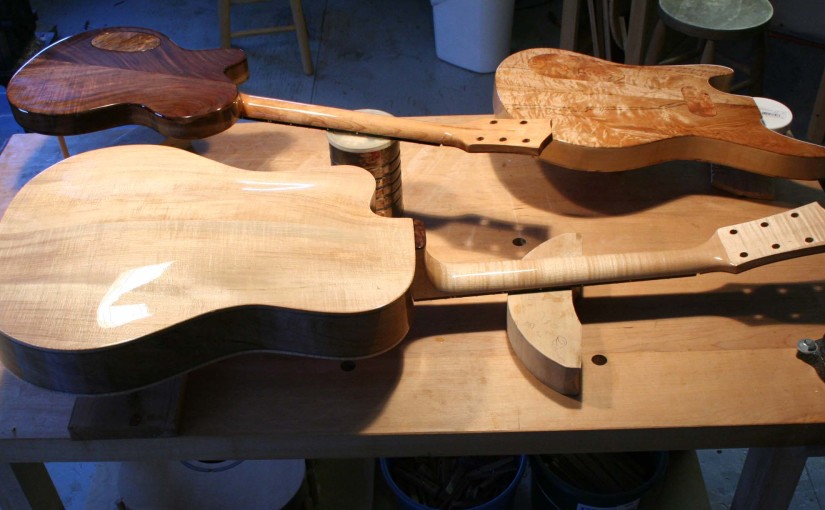My finishing schedule has been adapted through many attempts with a variety of finishes, and is suited to hand-applied finishes, and gives predictable results. This is more difficult than it sounds. Elsewhere I may list the combinations that didn’t work, and why – for now, here is what I do.
Start by sanding everything to at least 400 grit, starting with 80 and going through 120, 220, up to 400. Some parts come off the drum sander which runs a 60-grit belt, and extra thickness, a few thousandths, must be left on the material to allow for sanding back through the deep scratches from the drum. I use a cabinet scraper interchangeably with sanding to level and smooth surfaces.
Wipe down the surfaces to be finished with a tack cloth, and apply a coat of de-waxed shellac. Shellac that is pre-mixed and sold in cans usually contains wax which makes it unsuitable as an undercoat for oil or other finishes. If you use pre-mixed shellac, it must be identified as ‘de-waxed’ – this is usually only found in pre-mixed shellac marketed as a ‘sealer’. Shellac is available in dry form as flakes, and these are also both ‘waxed’ and ‘de-waxed’. If you mix your own shellac from flakes, use de-waxed flakes and dissolve in solvent alcohol at the rate of about 1 pound of flakes to 1 gallon of solvent alcohol, making a ‘1-pound cut’. This is a pretty fluid consistency suited to sealing. I use disposable foam brushes and apply the shellac to cover without runs.
The purpose of the shellac is to seal the wood, raise the grain for the final sanding, and provide a substrate that lets my oil-based top coats dry on oily woods. The oils in some woods used in guitar construction, like rosewood and cocobolo, will prevent oil finishes from curing, indefinitely. A sealer coat of shellac overcomes this problem.
The shellac is dry in a very short time. After allowing an hour or so, I apply a pore filler to any woods that are open-pored. Those woods include mahoganies, walnut, koa, rosewoods; you don’t fill woods like maple, cherry, spruce. I use a microballoon water-based filler (from LMI) that can be tinted with artist’s acrylic colors. I smear the filler on with my fingers, wipe most of it off by rubbing a cloth across the grain, and let it dry. Again, this dries fairly quickly. Then sand it all off with 400 grit except for what remains in the pores. This step also levels the grain raised by the shellac base coat.
Now the top coats begin. These number between 3 and 7, depending on how things look. The object is to build a layer of finish that is thick enough to be sanded level for final polishing out. I use a marine grade spar varnish. This varnish is on the soft-side as varnishes go, but applies smoothly by brush and does a nice job of enhancing the natural color of the wood. The varnish can be tinted with oil-soluble dyes, and small amounts of dye added to each coat will build up a distinctive color cast over several layers. The dye, when I use one, is first dissolved in paint thinner, and added to the finish in small amounts. The finish as it comes out of the can is too thick to flow well – it is sold that way to meet VOC compliance – and must be thinned with thinner or turpentine. I thin approximately 20% – or, one teaspoon of thinner per 5 teaspoons of varnish. Eight teaspoons of varnish is enough for one coat on a guitar, again, applied with a foam brush. I use props inserted though the soundhole to support the instrument as it dries.
The varnish takes longer to dry – typically it is dry-to-touch in about 4-6 hours, and hard enough to sand in a day. On the safe side, I wait at least 2 days between coats before sanding. This means putting on 7 coats takes 2 weeks. Sand minimally between coats with 400 grit, and remove any runs. Repeat until the finish is thick enough.
Now, wait at least 2 weeks. The longer you wait, the easier the buffing out will be, and the better the gloss. Sand everything back with 400 grit to level the surface. Move to 600 grit and sand some more. Move to 1000 and repeat. All these final sanding steps are done using water with the sandpaper as a lubricant. Let the instrument set a couple days.
Switch to autobody buffing compounds. Go over everything with a ‘medium-cut cleaner’, applied by hand using a soft cloth. Repeat with a ‘fine-cut cleaner’. Then go to a buffing wheel with a medium fine polishing wax, and it is done.

